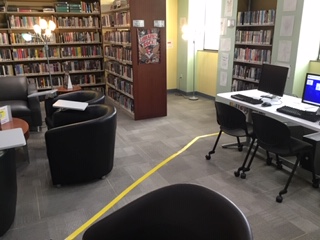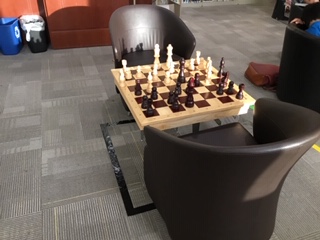How To Build An Escape Room on a Shoestring Budget
An escape room is an engaging and educational program for teens, even on a limited budget.
One hour. That’s all the time you have. You are trapped, facing certain doom, and survival is entirely in your hands. No one’s coming to help you...well, unless you ask, and then it will cost you five minutes.
Relax! It’s not a dire emergency, it’s an escape room. Commercial escape rooms can be very elaborate, with specially designed sets, custom built devices, and even live actors. And all of that is expensive. But you can do an effective escape room and spend practically no money at all. Everything you need is probably already at your library.
When we were brainstorming events for our Teen department at the Williamson County Public Library in Franklin, TN, we decided to plan an escape room as our Summer Reading finale… with less than two months to prepare. Had we ever hosted an escape room before? No. Did we have a budget for this? Nope. Did we have any idea what we were going to do? Nada. Had we ever been to an Escape Room? Well, one of us had. Once. So that, at least, gave us a starting point.
Research and Brainstorming
The first thing we did was go through notes from the webinar “Creating Escape Rooms Programs & Other Immersive Experiences in Libraries" hosted by Ellyssa Kroski. Then we hopped onto the Internet and cobbled together some ideas from other libraries, adjusting them to fit our needs. We realized we were going to have to think creatively. We could only use our Teen Room, which fortunately has doors that shut—but the room had to also be available for patron use during the program. This ended up working out great as patrons came in and out, and some even began participating after using the room to study and overhearing all the fun the team was having solving the puzzles.
We then came up with our theme—the ever-popular British science fiction show Doctor Who, a favorite of our teen patrons. For those unfamiliar with the show, every episode features the time-traveler named “The Doctor” as he escapes and defeats nefarious alien enemies—a tailor-made theme for an escape room. The Doctor’s time machine—the TARDIS—is a blue Victorian British phone booth which is “bigger on the inside.” When the characters pass through the door, they find themselves inside an enormous room, just like our teen library room! We had a room, and now we had a theme.
Design
Next up, decorations. We realized that we could decorate our door like the TARDIS, which only required some blue and white paper, a pair of scissors, and tape. That left the room as the huge interior of the spaceship. We “sealed off” sections with “force fields”—lines of colored duct tape placed across our carpet. The players would have to solve clues to open these force fields so they could enter the lined-off section. We used matching pieces of tape stuck to a clue (i.e. written on an index card in Sharpie) as the “key” to the next “room” the players could enter. We not only had an escape room, we now had more than one room—all created with duct tape!
Story
Now we needed a story to match our theme: Who and what were the players trying to escape? This too, was easy. We decided that the TARDIS had been infiltrated by one of The Doctor’s many enemies, and that they had stolen The Doctor’s favorite tool— his “sonic screwdriver”— and hidden it inside the TARDIS. These enemies were responsible for the force fields, and had left clues to taunt The Doctor with their triumph. We hid a replica prop of the screwdriver (purchased for less than $20 from Amazon) inside a locked drawer in our video gaming cabinet. Our players’ goal would be to follow these clues to locate the key, find the sonic screwdriver and open the TARDIS door.
Tip: The more the room contains in the way of furnishings, decor, or other objects, the more places to hide clues and the ability to create puzzles around the objects—or serve as red herrings. In our room we have game shelves, a dedicated chess table, iPads, and a few bits of decor (notably a homemade LEGO head and mask and drawings by our teen patrons). We hid clues in the LEGO head, behind the drawings, and in the board games (including Clue, of course). We used the chess table and pieces as part of a puzzle, and created a puzzle to reveal the passcode for an iPad, which held another clue. And, of course, we have books.
 Our bookshelf area was the starting point. With books about time travel or with words like “time,” “past,” “present,” and “future” in the title, we had great thematic places to hide clues and codes. Even the call letters on some books made words themselves, to which clues could point: CAB, SALES, ASH, WELL— all we had to do was create suitable riddles, and trust the teens to find the answers. (Remember: If you use books as part of a clue or puzzle, make certain you hold copies to have available on the day of your program.)
Our bookshelf area was the starting point. With books about time travel or with words like “time,” “past,” “present,” and “future” in the title, we had great thematic places to hide clues and codes. Even the call letters on some books made words themselves, to which clues could point: CAB, SALES, ASH, WELL— all we had to do was create suitable riddles, and trust the teens to find the answers. (Remember: If you use books as part of a clue or puzzle, make certain you hold copies to have available on the day of your program.)
Script and Hints
Next we wrote our script, or a progression of clues. This is where your creativity and knowledge of the theme comes in handy. Use clues that are both general and specific so that teens are equally challenged and nobody feels left out if they are unfamiliar with the theme. For example, an index card reading “You next clue is a bit of a wrinkle,” points to Madeline L’Engle’s A Wrinkle in Time, which doesn’t require any knowledge of Doctor Who to solve. We had a great combination of teens in our groups.
Once your script is set, expect that teens may get stumped, so prepare some general hints to spur them on, like quotes or book-related information, as well as a penalty for their request for a hint. We deducted five minutes from their time for every hint request. If your players have to ask for more than two hints with any particular puzzle, it’s probably best at that point to tell them directly what they’ve missed.
We scheduled the escape room to involve groups of eight players or fewer at a time. This gave everyone opportunities to help solve clues. Since the escape room lasted less than an hour, and set up was quick—we recruited finished players to assist in restoring the clues—we were able to do two programs back-to-back. The event was hugely popular, bringing new teens to our library (we left flyers at a local comic book shop), and the small groups worked to our advantage, creating both a learning and engaging environment for the participants—all for less than $50. On top of that, it’s a program we’ll be able to easily repeat in the future (no time-travel pun intended).
Erin Holt is a former Librarian at the New York Public Library and Williamson County Public Library (Franklin, TN), and has been working with teens for 10 years. While she is no longer in the library field, she keeps current by writing both Teen and Women's Fiction book reviews for School Library Journal, Library Journal, BookPage, and Booklist. Erin lives in Nashville with her husband Jerry and their two children, Duncan (8) and Winnifred (6).
Howard Shirley is a professional writer and part-time Teen Library Assistant at the Williamson County Public Library. A long-time fan of logic puzzles, strategy games, and role-playing games, Howard loves bringing these experiences to teens through original library programming. Howard lives in Franklin, TN with his wife, Betsy, and (in the summer) their son Alexander, a college senior.
RELATED
The job outlook in 2030: Librarians will be in demand
The job outlook in 2030: Librarians will be in demand
ALREADY A SUBSCRIBER? LOG IN
We are currently offering this content for free. Sign up now to activate your personal profile, where you can save articles for future viewing






Add Comment :-
Comment Policy:
Comment should not be empty !!!
Debbie VanZandt
I would love to share ideas! I have done escape rooms for Grad Night at my high school for the last 4 years. I even did a Dr Who-themed one, but you mentioned some things I'd love to add to that!Posted : Nov 20, 2019 08:18